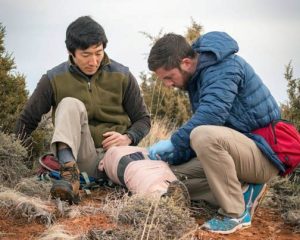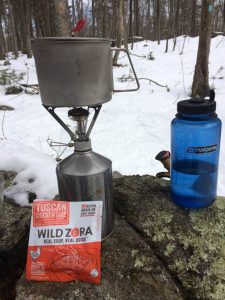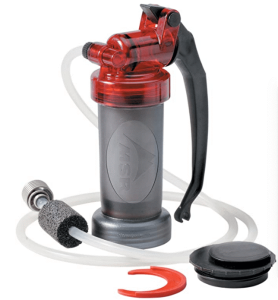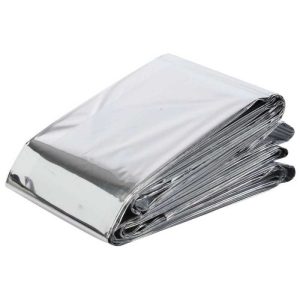Living in modern society, we’ve lost the understanding that things like warmth, food, and water are requirements that meant life and death for our ancestors. Backcountry hunting, fishing, and adventuring have always been a reset button for me, and therefore, is something I do as often as I can. However, I am always conscious of safety and prepare for emergencies in the backcountry.
Preparing for Emergencies in the Backcountry

Some dangers when out in nature are obvious, but others such as hypothermia or Giardia are often forgotten until it is too late.
Throughout the years, I’ve learned and been mentored on the essentials that make backcountry adventures as safe as possible. I would be remiss in not saying that at times, I’ve been lucky. However, the more I study, know, and practice, the “luckier” I seem to be.
To be clear, the backcountry is nothing to be afraid of. Getting the proper equipment, knowledge, and practice will get you out and back to civilization safely. It’s being ill-prepared that gets people in trouble, and there’s no such thing as being “over prepared.”
I’ve always liked the phrase, “Two is one, and one is none.” Something I’ve been reminded of time and again from my dad, friends in the military/veterans, and backcountry enthusiasts.
No, I don’t think it means having two of everything. Instead, take this to mean that when something is necessary for your life, don’t leave it to chance and rely only on a single item.

If you do not have a water filter, be sure to boil all water before cooking or drinking it.
Before we get into the nuts-and-bolts of what to bring to keep yourself safe, we need to discuss the basic dangers, which are: injury, food/water, illness, and hypothermia. Injury is one of those inevitable circumstances that if you do anything long enough, there’s a good chance you’ll run into a situation. It can happen at any time and any place. It may come in the form of something as minor, but regrettable, as poison ivy. A wound can range from a scrape to a deep gash, broken limb, or even worse. Sure, many of these things can happen walking on a hiking trail in a park. However, activities like hiking under a heavy load, gutting an animal with extremely sharp knives (dull blades pose an even greater hazard), and carrying/using firearms all compound the risk.
Conversely, you can bring all the medical supplies in the world, but if you don’t know how/when to properly implement them you might as well have left them in your vehicle. Arm yourself with as much research on where you’re going, hazards that exist (weather, predators, snakes, terrain, water-crossings, etc.), and backcountry first-aid. If you have access, training is even better. From a first-aid standpoint, you can assemble your own, or there are plenty of ready-made medical kits on the market that are worth their salt. When hunting and fishing, we tend to be more focused on our goal and become a bit more careless of our safety. Don’t become complacent… safety is always #1.
For brevity of this discussion, I’m going to assume you’re able to find food in the form of hunting and/or fishing Don’t take this ability for granted and overlook the local flora. It pays to know what plants are edible where you’re going. For example, if you are Dall sheep hunting in Alaska you can almost always count on mountain blueberries as a daily supplement. I said “almost” because bears may have cleaned them out, they may not be ripe, or perhaps none are in your particular area. Again, research where you’re going and what’s available.
Emergencies in the Backcountry: Water
You can live without food for approximately three weeks, but you can only live without water for three days.
Typically, if you’re heading for the backcountry, you’re going to stay reasonably close to a water source, whether it’s streams, lake, pond, etc., but you should always be prepared to treat the water before drinking it. A good water filter is well worth its weight. Emergency filters such as filtering straws, etc. cannot, and should not, be counted on for your daily water needs.

The MSR MiniWorks EX Microfilter Water Filter is small and compact but great for backcountry adventuring!
Contaminated water can make you painfully and even dangerously sick. In the backcountry, you should consider all water contaminated. One of the more common pathogens, Giardia, is found wherever mammals live, and it’s at the very least no fun and a long recovery if you contract it. Having to deal with Giardia in the backcountry can quickly become deadly. Fortunately, there are hundreds of water purifiers on the market. I prefer pump-type purifiers for their convenience and large volume output. However, they are mechanical, so they can break, freeze, etc. Also, if you’re filtering heavily silted water, it can clog.
Having a backup method is key. Some use purifying droplets such as Aquamira, iodine tablets from companies such as Coghlan’s, and others simply boil their water. Typically, you’re going to have a stove when you travel, or at least fire of some sort, and boiling kills everything. What’s the best? That depends on where you’re going and your preference. Because an otherwise healthy individual can die in a short time without water, you should always have two methods of purifying your water.
Emergencies in the Backcountry: Hypothermia
Hypothermia can be the result of a number of unfortunate circumstances but the danger is the same, your body is cooling down faster than it can warm up. Unbeknownst to most people, you can get hypothermia just about anywhere when the right (or wrong) situation presents itself. A few minor items in your pack can mean the difference between being comfortable, surviving the day, or disaster. Yes, these safety items add weight. Fortunately, many items are only a few ounces and several have multiple uses, which helps to cover our “two is one, one is none” motto..

Knowing the signs of hypothermia from the onset are critical for survival and preventing a backcountry emergency.
I’d rather carry a little extra weight than be shivering and wishing I had. Even if you’re perfectly safe, the quickest way to have an unenjoyable experience is to be miserably cold the whole time. To combat this problem from the get-go, remember that layering is king, and pack accordingly. I prefer synthetics and wool due to their ability to function when wet, although wool is typically heavier, and takes longer to dry it has the benefit of creating its own heat when damp.
Here’s a list of things I take into the backcountry regardless of where I am going.
For addressing injury, I like the Blue Force Gear Micro Trauma Kit NOW! It’s a small package that covers many first-aid tasks. The kit has multiple attachment styles, colors, and set-ups. With the addition of QuickClot Combat Gauze, Nasopharyngeal Airway (NPA), and duct tape, the “basic” setup will suit most people’s’ needs for minor and major problems.
Emergency Blanket

A simple Mylar blanket may be used for a variety of survival solutions in the backcountry.
Another item that can save your life and weighs very little is an emergency blanket. When the body goes into shock, which it can for multiple reasons, you lose body heat. Wrapping in an emergency blanket, regardless of temperature, is standard procedure for backcountry medics treating shock. An emergency blanket may also help with food and water issues. If you need water, and aren’t near a source, an emergency blanket would make a good rain or dew catching system. You can also use the blanket to set up a makeshift shelter, signaling device, rain parka, or to wrap around you to sleep in a wet sleeping bag. The possible uses are only as limited as your imagination and research. Needless to say, an emergency blanket is a no-brainer.
Fire
Last, but not least, is a heat source. Whether it’s a campfire or small packable stove… fire still reigns as the “can’t do without.” A nice campfire or pack stove has many benefits, including drying clothes, boiling water, cooking food, and warming your body. In order to start a fire, there are easy to use products such as lighters and waterproof matches which are also very light, so they should always be in your pack. Unfortunately, both of these can fail, and failure in the backcountry can mean death. Some additional/alternate options are to carry a flint/spark stick or magnesium fire starter. I’m paranoid enough to I carry all three.
Emergencies in the Backcountry: The Duct Tape Solution
Duct Tape
I often use duct tape to address injuries. You can close a cut, make a splint, and it’s also great for taping gauze around a wound. Simply fold the duct tape (not gorilla tape; when that stuff sticks together it doesn’t come apart) on itself. Five yards of duct tape easily fits anywhere in your pack or kit. Duct tape can also be used to temporarily repair your tent, sleeping bag, boots… nearly anything.
Additional Items To Consider to Prevent Emergencies in the Backcountry
Trash and Ziploc bags, more duct tape, shoe goo (use for more than shoes), superglue (which I’ve also used to close wounds), signal mirror, cleansing wipes for hygiene, LED headlamp, moleskin, Aleve/Motrin or other anti-inflammatory, tourniquet, paracord (can also be a tourniquet), a squirt water bottle both for drinking and cleaning a wound…did I mention first aid knowledge and duct tape? The backcountry can be dangerous or docile. Now you can be prepared for both.
Do you have a list of must-have items for emergencies in the backcountry or an item that should have been added to this list? Share it in the comment section.
Cocked and Locked is the official content provider of TheBestShootingSite.com. Be sure to also check out: John Bartolo: The Most Dangerous Man in the Firearms Industry.

